Think Splinterlands is Dying? Think Again.
The Decentralized Dream of Splinterlands is the Saving Grace.
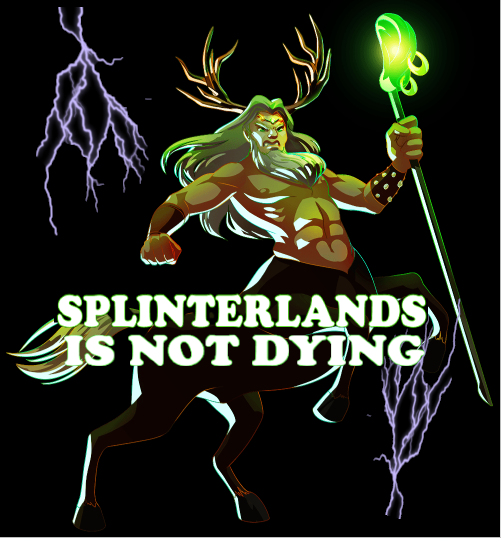
Gimmicks, adjustments, proposals, and faith in the corporate leadership are not what will keep Splinterlands alive. In fact, what will keep Splinterlands going in spite of the calamity of events that have taken place over the past 12 months has nothing to do with hype, pivots nor flashy decisions. The commitment to decentralization and humility to accept that others could and will use card assets in different ways is what will keep the spirit of Splinterlands alive, even if Steem Monsters Inc. is not able to stay in business.
It is important to grasp an idea of where things are to get an understanding of where things could be and understand the mixture of hope and mild resignation that game/ecosystem founders Dr. Jesse "Aggroed" Reich and Matthew "YabapMatt" Rosen have expressed. The best way to present it all is with a traditional strategic management and planning technique known as SWOT (Strengths, Weaknesses, Opportunities, Threats).
Splinterlands' Strengths
A Devoted and Active Community
For much of the crypto-bearish year of 2022 and despite many difficulties, there was a core of 10,000 to 14,000 Daily Active Human Users. There is an active community that cares about the game and ecosystem, even if the assessments are not what company executives necessarily want to read or hear. For a comparably smaller game in userbase compared to Web 2.0 and more mainstream gaming options, there are influencers and media personalities that present their own take beyond what is featured on the official SplinterlandsTV Twitch account.
Product Maturity
Splinterlands has been around since 2018 and is a dependable, functional game with rare bugs and immediate fixes. Security, an accessible API, a robust marketplace, 3rd party integrations, improving artwork quality, and a commitment to improving the gameplay experience are points of pride and emphasis.
Minor gameplay experience details matter as the simultaneous Poison and Earthquake effects between rounds were implemented and the Cripple effect was strengthened so that it could not be cleansed away like the way a Poison status could be removed. This enhanced the strategy of the game and improved the value of Dallan, one of the newest summoners in the game, coming from the Riftwatchers Edition.
The balance of summoner and monster cards has been largely maintained to ensure that the game remains unsolved and that there are counters for any combination of cards in any situation. This balance is maintained with great thought from the development team, but also from the strong community playing a role in determining abilities and giving the development team an idea of how the cards will be used on the Quality Assurance (QA) server. It is in the best interest of the community that new cards do not become too strong or not create situations where existing cards become too strong as to ruin the gameplay experience. A prominent example was the decision to weaken of one of the most recent Rewards cards, Countess Sinash, after it was tested in the QA server.
An array of tokens, cards, tokenized packs, non-card items, tournaments, fraternal organizations (Guilds), gameplay variants, and even node licenses have been issued by Splinterlands. It is tough to appreciate, but this is a far more mature product compared to most Web3 gaming products.
Prior to the Chaos Legion pack burning initiative, over 10 million Chaos Legion packs were purchased or distributed through an earned Reward. This is the primary edition of the 3rd Generation of cards issued by Splinterlands.
Splinterlands First Generation: Alpha and Beta
Splinterlands Second Generation: Untamed and Dice
Splinterlands Third Generation: Chaos Legion and Riftwatchers
Splinterlands aims to issue out a Fourth Generation of cards with the primary edition being titled "Rebellion", which is to be issued at an undisclosed and possibly undetermined date in what is speculated to be in either the latter part of the 2nd Quarter of 2023 or the earlier part of the 3rd Quarter of 2023.
The maturity of how Splinterlands brings the game to life helped with the launch of Genesis League Sports and the initial sports title "Genesis League Goals", which is a partnership between Steem Monsters and the Major League Soccer Players' Association.
Brand Strength
Splinterlands enjoys greater brand recognition than 99% of Web3 games. Splinterlands has such brand strength that it could afford to hold their own festival (Splinterfest) much like the way other game franchises hold on an annual basis.
Splinterlands has plenty of press releases, gained recognition from niche and mainstream outlets, and created a special summoner in partnership with Waka Flocka Flame (Waka Spiritblade).
Compared to most Web3 gaming projects, Splinterlands' brand and game recognition is so far ahead that it is unfair to associate them with many of these games and projects.
3rd Party Relationships
Tools and service providers enjoy a strong relationship with Splinterlands. Splinterlands even refers these service providers to players as they are so popular to use.
- Splex.GG
- PeakMonsters
- MonsterMarket.io
- CardAuctionz
- SummonerLab
- Layer2Labs.io
- Baron's Toolbox
Having dedicated 3rd party services and tools that enjoy community support and usage is a testament to the support that Splinterlands receives.
Splinterlands' Weaknesses
Fulfilling Promises on Time
"Wen Land?" is the meme that dominates social media platforms because of the two year wait for the Land feature to enter the game and make an impact. Land is expected to be transformative and has already proven to be lucrative for those who initially invested into Splinterlands, but the inability to bring Land to those who made the initial investments that make the present version of Splinterlands possible.
Road Map development delays have been an unfortunate cornerstone of Splinterlands and expectations of projects meeting milestones have been frequently delayed by at least one quarter.
Marketing
"Who is the target audience for Splinterlands?"
The answer one will get is both vague and uninspiring. It is a simple answer of people who like fantasy. There has not been a nailed down concept of the target audience(s). No user personas and no clear marketing direction.
The marketing effort can be broken down as follows and it is dispiriting.
Waiting for Bitcoin to enter a Bull Cycle
This is not a marketing strategy at all. In fact, this is a recipe that leads to shuttered doors. Businesses cannot be reliant on another business or entity to carry them through. A business with only one client is a business that is not going to survive if the client changes product or service providers. Dependency without diversification will lead to bad results.
Hoping that Bitcoin turns things around speaks poorly to how the corporate team perceives their game. With this attitude, there is an unspoken belief that this game cannot stand on its own. It needs forward momentum from another entity in order for the game to succeed.
The game should be enjoyable and the tokens, NFTs, and licenses should be able to withstand market sentiment toward cryptocurrency. Web3 gaming should be able to compete with traditional games without having to be reliant on market elements for growth of the player base.
Embrace of the "Weebs"
Splinterlands is a strategic auto-battler card game with a Decentralized Financial Gacha ecosystem. It can attract all sorts of audiences who enjoy competitive and strategic games. Instead, the decision was to lean on the artwork and lore to attract an audience that can struggle with the mainstream. Does this lore or artwork truly connect with the audience? It does not. In fact, the only interest in lore comes connected with some sort of a financial reward because of the Hive blogs written by community members with the hopes of receiving upvotes (largely from the Steem Monsters' account) and the currency associated with it.
The fantasy element was supposed to hook people into the game. The promise of table top games like Magic: The Gathering or Dungeons and Dragons and comic books and animated series featuring the characters was to be a selling point for owning the assets.
Instead, many in the community are not necessarily the audience the founders envisioned and the strategy, ownership, and ecosystem are actually most appealing.
Attracting NFT investors... during the NFT bust.
Runi, a customizable in-game NFT asset that allows players to express their personality was made available on OpenSea. The targeted audience was not necessarily existing players, but rather NFT investors who use OpenSea. New capital and a new market was the objective, but instead most of the audience creating Runi characters were already existing members of the Splinterlands community.
NFT sales volume has fallen considerably as a whole. Runi was an effort that was a mix of "too little, too late" with Runi's launch in September 2022 and vanity project that was designed to impress people at conferences.
Snapchat Advertising
Mid-roll advertisements featuring Cryptollama explaining Splinterlands and presenting the game as "Play 2 Earn" (which is a rough label as-is) have greater ubiquity. The advertisements come in two different flavors featuring Cryptollama and do not seem to have any sort of a targeted demographic beyond those watching videos from content creators on Snapchat.
Hive Blogs
The blog content largely follows one of two paths on Hive.
"Share Your Battle" posts that are essentially template content. The result of which is basically an attempt to create a sloppy instruction manual. This content does nothing to bring anyone to the game, but it does make the game look like a sloppy grift with a community just looking to make a quick buck off an upvote. It is a BAD LOOK.
Personal journey content with the game that is both short and quite bad considering that the content has very little thought to it. Content quality regardless of language is incredibly low and what is rewarded is usually of the poor quality variety. Most of the content that is rewarded, especially by the large issuer of rewards (steemmonsters), aims to make the voter or the organization itself feel good about themselves in an unfortunate and patronizing way. The desire to feel like they are changing the world or helping the unfortunate outweighs good sense as game developers and marketers.
The Past Six Months Have Been Rough
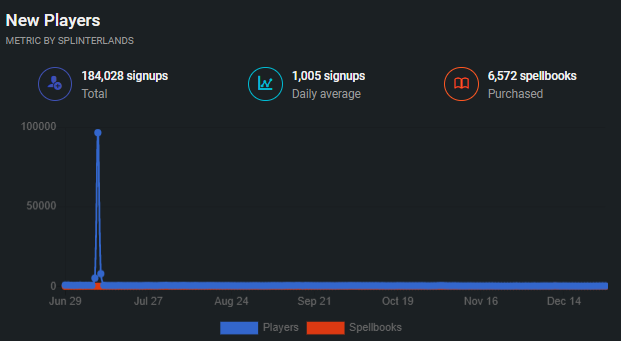
It was tough prior to new Ranked Rewards too

Splinterlands Strip Mining
The objective is to extract as much as possible from Splinterlands at the lowest cost, so it seems. There are multiple ways to reach this goal, but the bot farms are strip mining the game. It's less of a game and more of a mining expedition lending the outcomes of ranked battle rewards to resemble Proof of Work token and NFT mining rather than a strategy game that incorporates decentralized finance and ownership.
Splinterlands' game play is mostly comprised of script accounts of two kinds.
Mining Operations with the intent of extracting SPS, packs, and rewards cards to sell all of the assets in the secondary marketplace and withdraw funds. These operations can be as large as 50,000 accounts that are run by scripts that have miner-seller-holder-owner roles. These accounts operate in sales volume and the largest mining operation is struggling to sell in-print Common Rewards cards. In fact, the largest mining operation owns 30% of Regular Foil Blood Maker, Vampire Bat, and Ever-Hungry Skull cards in circulation and it can be found in their holding account.

These accounts will often rent cards just to be able to qualify for receiving rewards, face other botnet script accounts in Bronze or Silver League, and sell the lion's share of Chaos Legion and Rewards cards on the secondary market.
Their impact has resulted in the premature mass-printing of Rewards cards, which has resulted in the value of Rewards cards declining to near-burn price levels on the secondary market. The cards have utility in matches, but have little financial value.
Competitive Bot Scripts are the new way human players are choosing to play the game and live their normal lives without Splinterlands taking up 30 minutes to an hour of their day. These scripts are either proprietary and not available to the public or are offered by service providers like Archmage and XBOT. Archmage and XBOT are available to the public and their licenses are tokenized in the Hive Engine Marketplace. They offer solutions that are "batteries included" and turn a Novice account into a Champion in a short period of time.
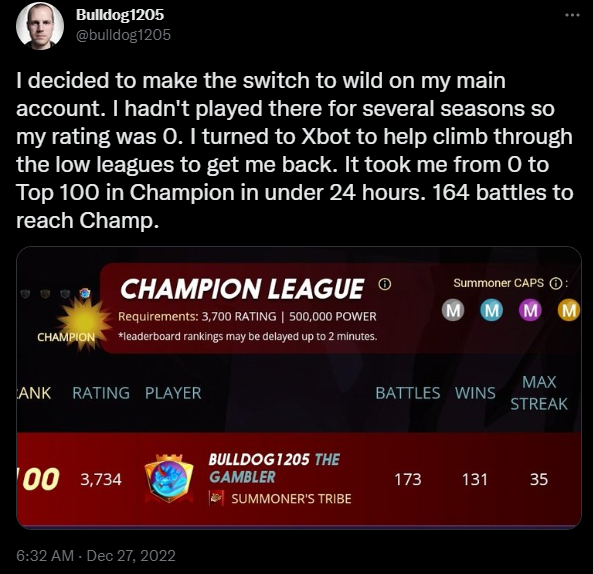
The point of doing such a thing is twofold: (1) Reach Champion League and receive the best SPS rewards and odds of receiving Gold Foil Rewards cards, Legendary Rewards cards, and Chaos Legion packs. (2) Compete in tournaments and for Leaderboard Rewards that pay players in DEC.
There's no point to playing the game as the bot scripts have removed all need to do so. Extract what you can from Splinterlands and the potentially lucrative Attention Economy benefits that can be capitalized upon are neutralized. With the unnecessary nature of human play, Splinterlands is reduced to a mining operation. It's hardly a game anymore.
Tokens lacking utility and purpose
This is the daily price chart for SPS against the U.S. Dollar. This is the governance token of Splinterlands.
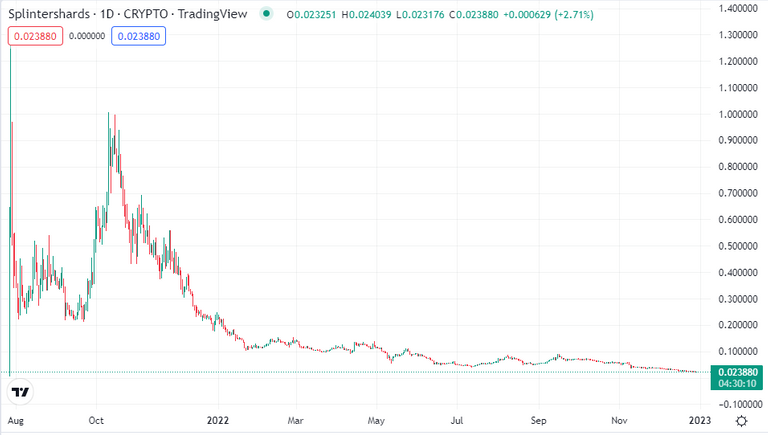
This is the daily price chart for DEC against the U.S. Dollar. This is the "stablecoin" of Splinterlands.
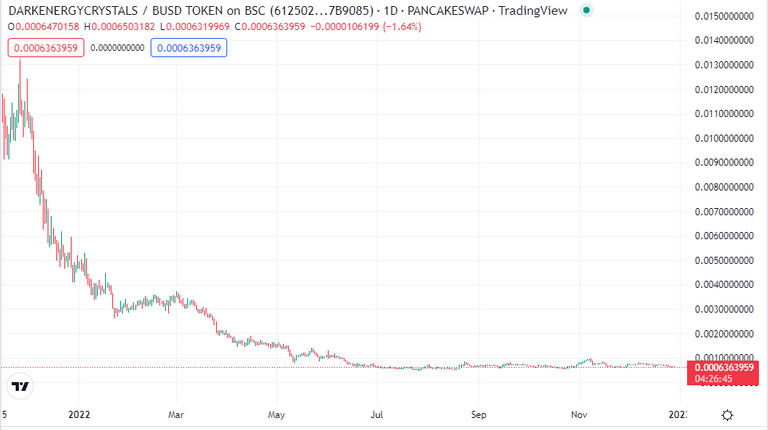
This is the daily price chart for VOUCHER against Hive. This is the coin that is commonly used for special releases and presales, outside of that, it has absolutely no purpose other than to be hoarded and eventually sold on the Hive Engine market for a declining amount.
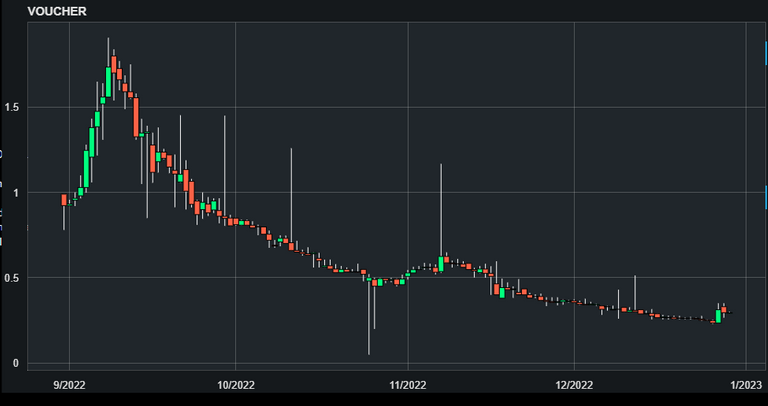
When it comes to utility:
- SPS is for voting, purchasing Riftwatchers packs, and staking to receive more SPS, VOUCHERS, and GLX tokens.
- DEC is for purchasing and renting cards, purchasing Chaos Legion packs, purchasing skins, purchasing guild buildings.
- VOUCHERS are just there and Splinterlands' development team just chooses arbitrary times to make them relevant.
The mechanism is to shrink the DEC supply so that players have to burn SPS to get DEC, which results in the SPS supply shrinking and in theory the price of SPS rises. However, with such little utility, where does the demand for SPS come from? Lower supply does not mean that there is inherently the requisite demand.
SPS is being distributed freely through brawls, tournaments, interest from staked holdings, and ranked rewards matches. The faucet is open and will remain open for another 4 1/2 years. If voting is not that important (which it is not) and there is more value to buying individual cards on the secondary market as opposed to opening backs, the token is generally meaningless.

1 SPS is roughly equal to 37 DEC, which is a far cry from 1:100 ratio that existed before the DEC price push by Splinterlands. Splinterlands' DEC bolstering initiative has been a massive failure resulting in a roller-coaster ride in the price of DEC. Poor treasury management has resulted worries about the future of Splinterlands, leading many to wonder if Steem Monsters can make it to the fourth quarter of 2023.
Poor utility, treasury management, marketing, and strategy have resulted in 3 plunging tokens with questionable futures. There are just so many manipulation techniques and "smoke and mirrors" efforts before there is an acknowledgment that there's a massive demand issue.
Splinterlands' Threats
Dependence on Success of Bitcoin
Riding on the coattails of another company or token is a bad idea as an overall strategy. Splinterlands loses agency and control over their own game and ecosystem by doing this and messaging things this way reduces trust from community.
If Hive falls below $.15 and Bitcoin drops below $10,000, where does that put Splinterlands? Splinterlands is backing their tokens with their own product, but leave their growth efforts largely to forces beyond their control.
It becomes less about effort and more about faith. Splinterlands becomes less of a business and more of a religion of the markets.
Raising Capital in this Environment
With every interest rate hike, company valuations fall. Valuation is an art, not a science, but valuation methodologies involving Discounted Cash Flows factor in the interest rate. Steem Monsters' valuation has fallen in 2022 and may be poised to fall further in 2023, if the Federal Reserve continues raising interest rates. Less easy money means less willingness to purchase equities on the private level or on a public marketplace.
If capital was to be raised, it should have been raised much earlier in the year.
Steem Monsters is at a point of relative desperation after cutting 45% of staff and confronting issues that largely stem from the inability to grow and take Splinterlands to the next level. Players are leaving, the daily active user data that was a point of pride is now a point of question and concern, and tokens are falling. Things were so bad that Aggroed mused about his own mortal demise and what that would mean for the game and company in an Emergency Town Hall.
Newfound skepticism and negative sentiment surrounding Cryptocurrency and Web3
Reduced valuations and greater share of ownership lost is one part of the equation, but the other part is the lower general willingness of investor participants in the wake of FTX's demise. Greater regulation shaped by misinformed and politically opportunistic elected officials and regulatory authorities will disincentivize investment in software companies with games that have a decentralized finance element to them in the United States. In the United States, poorly conceived regulations and laws are common with a misinformed legislative branch and general populace.
Higher risk and interest rates mean that investors will ask for much more in terms of ownership stake and there will be demands that force changes. The prospective investors hold significantly more negotiating leverage in this environment than they would have earlier this year.
Corporate and DAO are ONE?
The best way to present this issue is a series of questions that are seemingly unanswered.
- What is the difference between Steem Monsters and the Splinterlands DAO as organizations?
- Why aren't the publisher of the DAO (a financial institution issuing out a cryptocurrency to be traded on the market) and Steem Monsters (a gaming software company) kept separate?
- How does a DAO proposal reach the voting stage in the current format?
- Who is drafting the DAO proposals?
- How are Steem Monsters' activities behaving as a financial institution kept separate from Steem Monsters' activities behaving as a software company?
- How much transparency are token holders owed as far as how Steem Monsters manages DEC within their own organization?
- Given the possible classification as a financial institution, does Steem Monsters have the necessary guardrails, procedures, and internal enforcement to ensure that there are no conflicts of interest nor activities from employee and non-employee stakeholders that can harm both the company and token holders?
Splinterlands' Opportunities
The Community Steps Up
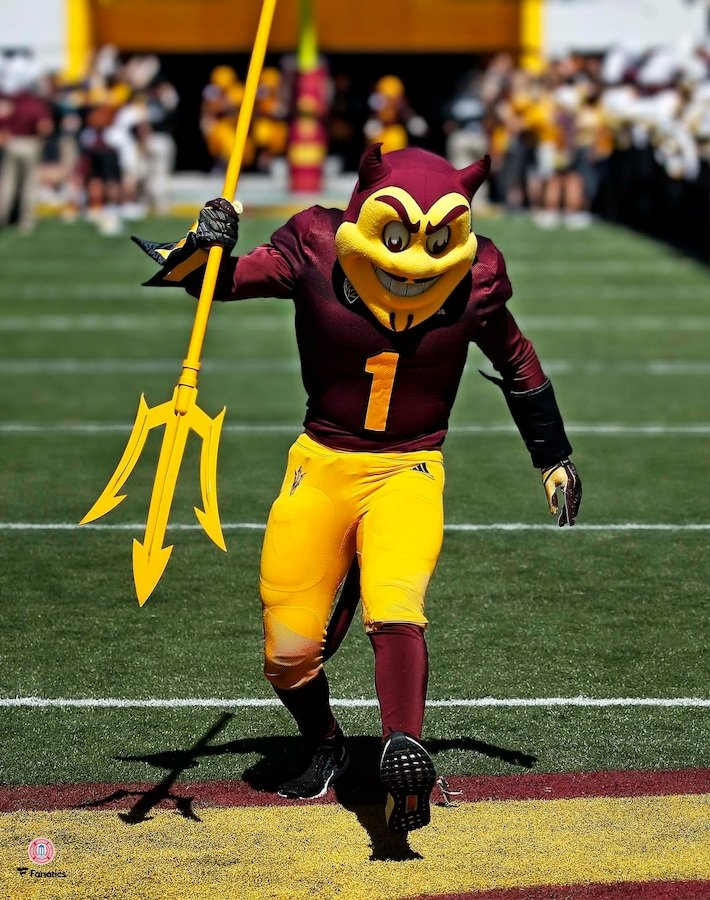
Sparky the Sun Devil Image Source
"Put a Fork In 'Em, Splinterlands is Not Done"
Those who think Splinterlands will just roll over and die are wrong. In fact, the future of Splinterlands is quite bright. This particular iteration of Splinterlands may have reached its peak with the team that is running the game, but it does not mean that Splinterlands is over. In fact, players might get more Splinterlands than they would have ever imagined and there may be more opportunities for people all around the world to get to enjoy Splinterlands in different ways.
"They walked, so we can run."
One of the most impactful statements of the year is made at the 2 hour 5 minute mark of the Town Hall from December 12, 2022.
"So yeah, we can easily prevent bots, right. We, we can just say like, you know, we could go in and say these accounts are not doing things the way we want them to do do it um you know if they're submitting a certain way or whatever they're not using our websites or whatever and we could do that. Lots of traditional games do that, even Web3 games like Axie Infinity does stuff like that, but that's not what we're trying to do here. Ultimately, we I like the highest level vision for this is we want this to be a completely decentralized ecosystem so that splinterlands.com is not the only website you can use to play the game. People could even build their own websites, people will run their own validator nodes for everything, not just SPS. All the cards, DEC, land... all that stuff they could run their own websites that let people battle they could even you know make a fork of the game and make modifications to it and make you know other changes that they want. So in order to have a decentralized system that means you don't have one centralized entity like our company saying who can play or how they can participate so that's part of the difficulty of what we're building here. We're not trying to build the same old thing, there are tons of traditional Web2 games that you can go play that do these things and work that way. We're not trying to compete with them, we're trying to build something new and different and it's going to be hard and you know we're going to make a lot of mistakes and we're going to try things and things aren't going to work and we're going to change them, but ultimately that's what that's what really I'm here for. I'm here to build the first game where uh you know it's fully decentralized, anyone can run it - it's distributed, it's not dependent on our company for anything. I look forward to the day where people are running their own Splinterlands websites and battle engines and nodes all over the world -- anonymously. So I just yeah I know I have talked about this before, but I feel like it's important to reiterate kind of over and over and over like this is the mission and this is what we are doing here. I think it can be beneficial to everyone who participates in it, but it's also not for everybody so you know hopefully everyone's clear like that this is what we're doing and this is why and if you're here, you're here because you support that mission." - Matthew "YabapMatt" Rosen
"Maybe at some point somebody will create the opposite of Pegaxy, where they're like we don't want bots in Splinterlands and we're going to create our own fork where we block them. You know, I worry about this stuff too. What if Koreans start making the most money, are we going to just block Koreans and then what if Americans do or what if people from Texas do or you know whatever demographic people you know are we going to start targeting them because they're making more money than you? I mean that's the antithesis of what we're trying to do here." - Dr. Jesse "Aggroed" Reich
So a hard fork it is and that's where the possibilities exist. Consider the following:
- Splinterlands without bots.
- Splinterlands with different marketing approaches.
- Keeping the built-in player base and building off it.
- Different user experiences.
- New Lore/Storyline that is relatable.
- Different structuring to put minds at ease.
- Internal protocols.

It's a parallel universe for Splinterlands and it can even be renamed. Maybe someone would eventually a create spinoff that is like Grand Theft Auto, but incorporate Splinterlands characters. This is a talented and passionate community that is getting tired of sitting on their hands hoping for something to happen.
2023 is the time for the community to step up and take the initiative and shake things up. Splinterforge is a project that will incorporate Splinterlands characters and give them new life in their boss-fighting game. This is the first attempt at breaking away from the Splinterlands canon while using the Splinterlands cards that the players actually own. It may be possible to play multiple versions of Splinterlands in a day and earn multiple types of tokens and cards with the same cards earned from the original iteration of Splinterlands.
Derivations, spin-offs, and hard forks are inevitable with Web3 gaming. Decentralization is the true opportunity and the best part is that by sticking with the Splinterlands community, there's a built-in audience ready to play and provide the necessarily initial social proof rather than starting from nothing.
Splinterlands is not dying nor dead by a long shot. There's a lot of work to be done, but it would be nice to bring the vision of Splinterlands' founders to fruition much earlier than they would have ever expected.
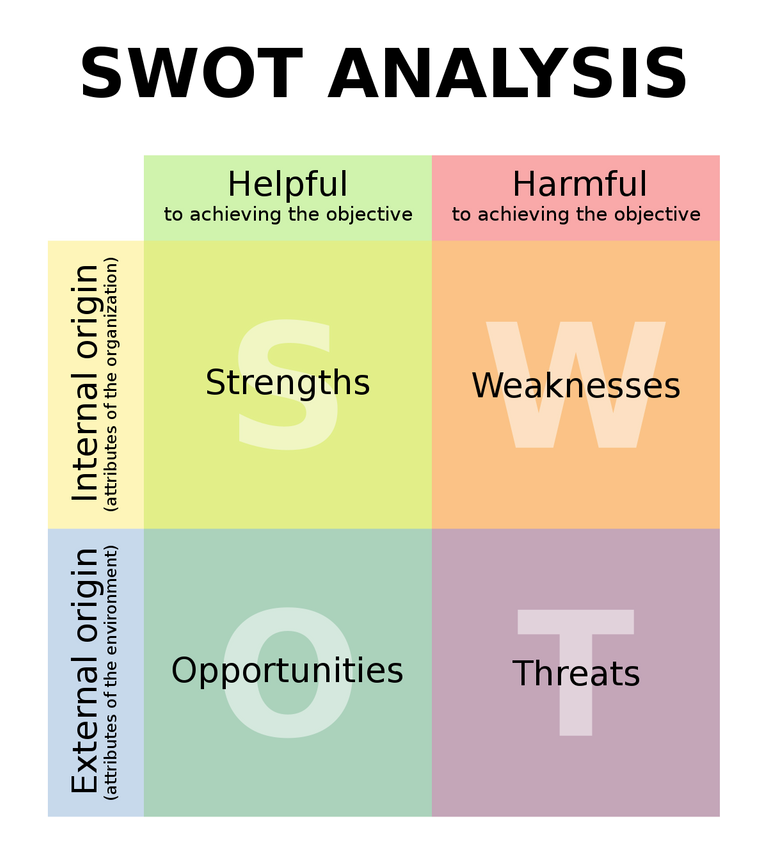
What a great post! You point out a lot of important aspects. My biggest worry is that the Splinterlands Team runs out of liquid funds. They probably oversized their team in the past and it will take time to redimension it and be more conscise with their development.
I have picked this post on behalf of the @OurPick project and it will be highlighted in the next post!
Their cash management and treasury situation is dicey, that's for sure. The amount of money they seek to raise because they put themselves into this predicament will be tougher to obtain.
The next article is going to be a layout of an alternative vision (a spin-off) of Splinterlands. 2023 is going to be a very exciting year. It's the year players go from asset owners to actual developers.
Excellent analysis!
True decentralisation actually requires the original founders to exit (or be exited) like Satoshi and Steemit Inc.
Kudos to the Splinterlands team for putting in place the building blocks of true decentralisation.
Wow that is an amazing post! Well done.
I think Splinterlands is here to stay!
Almost done 5 years and will easily to another 5 and more years!
Hellacious write-up and one one-sided. Brilliant on how you looked at both the good and bad sides of the project very levelly.